ISSN: 2511-7602
Journal for Art Market Studies
ISSN: 2511-7602
Journal for Art Market Studies
Ruth Sonja Simonis
This article discusses the acquisition of East Asian porcelain for the furnishing of the Japanese Palace, Augustus the Strong’s pleasure palace in Dresden. It focuses on two important documents that give information on how and where porcelain was purchased in eighteenth century Saxony: firstly, the historic royal inventories, compiled between 1721-1727, which not only record the interior equipment of the palace but also refer to a number of porcelain dealers from Dresden and Leipzig by name. Secondly, a set of letters between the Saxon court and Dutch dealers in the Netherlands provide us with information on the porcelain market in Holland between 1716-1718, a timeframe in which two charges of East Asian porcelains were acquired for the Japanese Palace with the assistance of resident merchants. The article aims to highlight the importance of these local correspondents for the assembly of Augustus the Strong’s East Asian porcelain collection and the networks these dealers made use of. Furthermore, it provides additional information on the provenance of selected objects from the extant collection of the Porzellansammlung Dresden by linking them to the above-mentioned purchases made in the Netherlands.
“The whole cabinet is furnished with gilded and painted Indian paper and ties of painted black Indian tuft, and the rest of the blue and white porcelain is all placed on cut and gilded consoles and small boards, painted red…” – Description of the sixth room of the Japanese Palace in the “Inventarium zu Alt-Dresden”, 1721.
Augustus the Strong (1670-1733), Elector of Saxony and King of Poland (fig. 1), had great things in mind when he purchased the Japanese Palace (fig. 2) in 1717 from his minister General Field Marshal Jacob Heinrich von Flemming (1667-1728). Not only was it to serve him as a maison de plaisance – a place where he could withdraw from stressful obligations and relax in an environment removed from the constant activities of the court – but it was also to be a venue where he could realize his vision of a “Porcelain Palace”, a building tailor-made for the display and presentation of his collection of East Asian porcelain and other Asian objects. Built in 1715 on the right side of the Elbe river, the small castle quickly became the scene of Augustus’ most ambitious dream: to showcase his East Asian ceramics collection, which encompassed around 25,000 objects in 1727.1
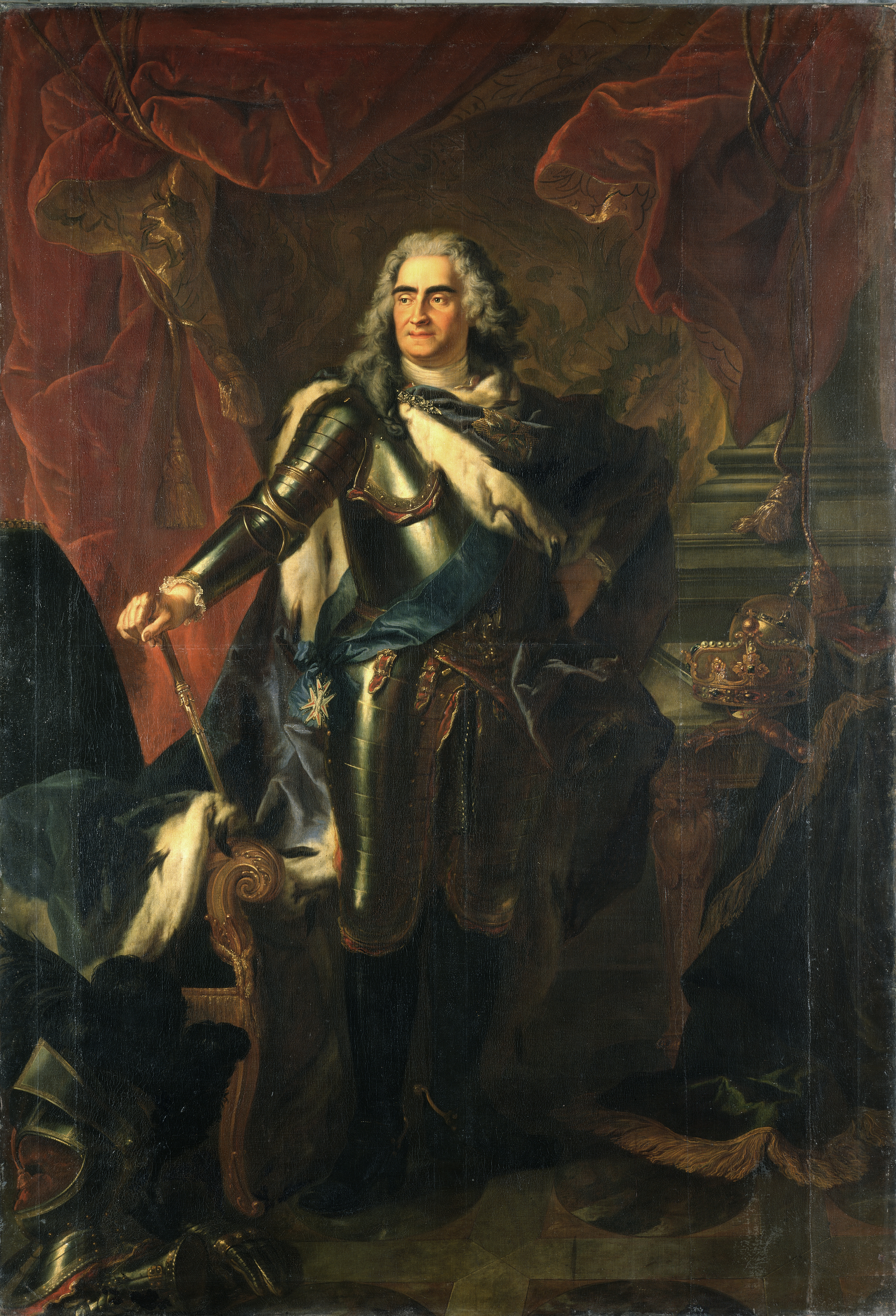
Fig. 1: Louis de Silvestre (1675-1760)
King Augustus II. of Poland (1670-1733), 1718, oil on canvas, 252,5 x 171,7 cm
Dresden, Staatliche Kunstsammlungen Dresden, Gemäldegalerie Alte Meister, Gal.-Nr. 3943
Gemäldegalerie Alte Meister, Staatliche Kunstsammlungen Dresden, photo: Jürgen Karpinski.
It had taken a long time to gather this amount of porcelain, which even back in the eighteenth century formed the largest ceramic collection of this kind outside Asia.2 The first pieces of Chinese porcelain that came to the Saxon court in 1590 were part of a present from Ferdinando de’ Medici (1549-1609), Grand Duke of Tuscany. Eight of these objects are today kept in the Porzellansammlung of the Staatliche Kunstsammlungen Dresden (fig. 3). However, it would be deceptive to assume that this present of porcelain led to a sudden increase in the acquisition of porcelain by the Saxon court. In fact, it was not until about 100 years later that the first systematic acquisitions under Augustus the Strong began.
Collecting and presenting porcelain had become a custom at the royal courts of Europe, beginning in the Netherlands, the place where East Asian porcelain had arrived first with the ships of the Vereenigde Ostindische Compagnie (Dutch East India Company, hereafter VOC) at the beginning of the seventeenth century. By 1700, almost every royal court in Europe possessed a porcelain cabinet, filled with the splendorous wares that came from China and Japan. The Japanese Palace in Dresden, however, was planned differently – not only one, but all eighteen rooms of the small castle were to be furnished with both East Asian and Meissen porcelain of different colours and décors, and presented in a matching interior decorated with East Asian tapestries, carpets and artworks. Today, we know which pieces of porcelain were kept in the palace and how the rooms were decorated due to an inventory (fig. 4) assembled between 1721-1727 under the supervision of Martin Teuffert, Bedmaster of the Japanese Palace between 1717 and 1763. Teuffert oversaw the interior furnishings, furniture and other equipment of the castle, including the porcelain collection of Augustus the Strong, as well as the recording of the King’s extensive ceramic collection.
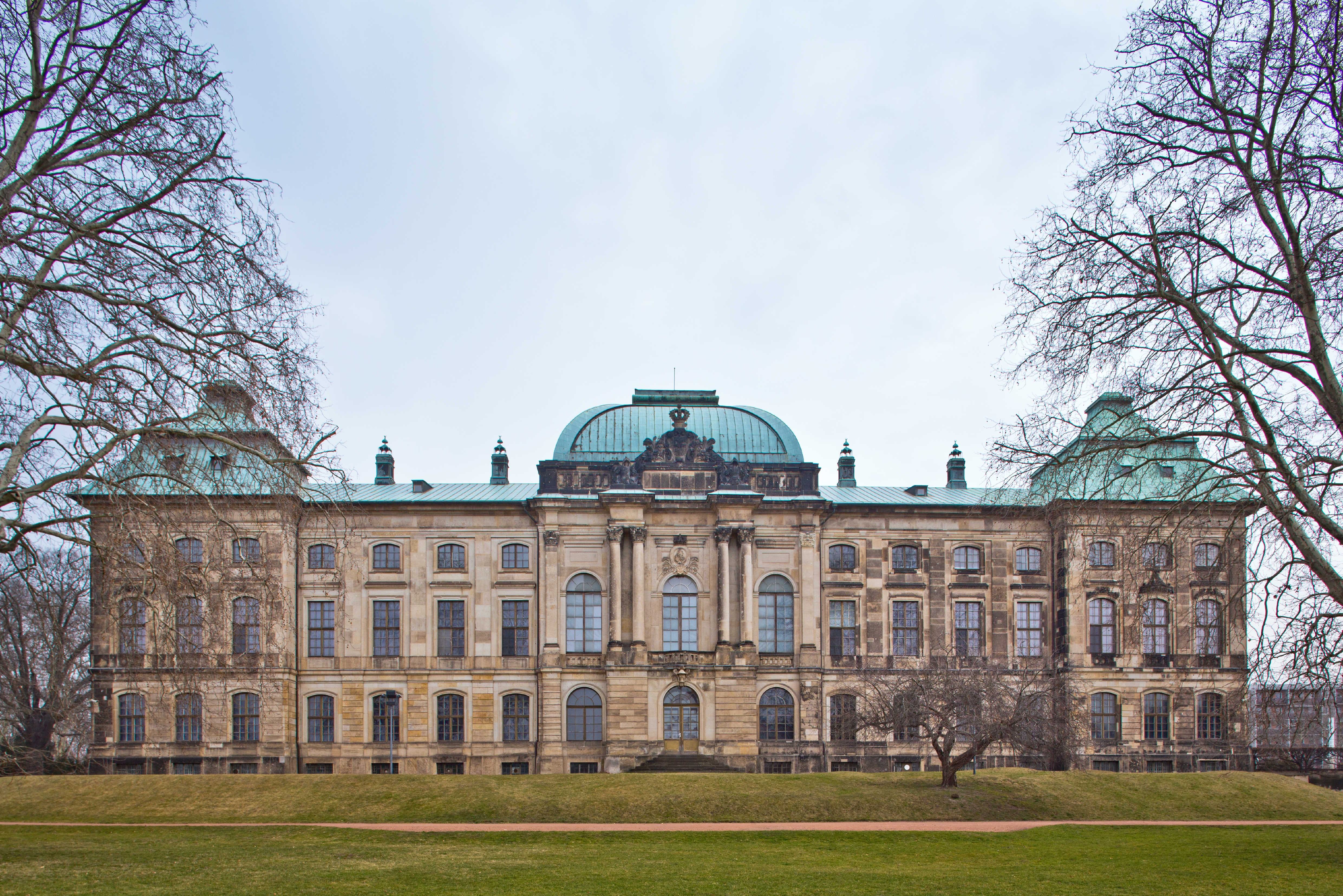
Fig. 2: The Japanese Palace (front facing the Elbe River), Dresden, 2014
Staatliche Kunstsammlungen Dresden, photo: Jürgen Lösel.
The inventories originally encompassed more than 1,000 pages, with the ceramic collection divided in ten chapters.3 Six chapters deal with the holdings of East Asian porcelain, whereas the other four are inventories of the collection of Weiß sächsisch Porcelain (chapter seven, white Saxon porcelain), Braun sächsisch Porcelain (chapter eight, brown Saxon porcelains or stonewares), Terra Sigillata (chapter nine, stonewares, today known as Yixing wares) and Schwartz indianisch und sächsisch schwartz laquirtes Porcelain (chapter ten, black Indian and Saxon black lacquered porcelain). Although a certain knowledge about the different countries of origin must have existed among Augustus the Strong and his fellow porcelain connoisseurs in the early eighteenth century, one cannot speak of an academically correct differentiation in the historic inventories. Despite a rough distinction between “Japanese” and “Chinese”, the various types of porcelain are mainly grouped in accordance with their colouring and décor. Chapter one, which is an inventory of the group Japanisch Porcelain (Japanese porcelain), includes all wares that were decorated in the Imari colour palette. Imari - porcelain originally produced around Arita in Japan and named after the port from where it was shipped to Europe – has a distinctive colour palette of dark underglaze blue, overglaze red, and bright golden decoration (fig. 5). The lavish motifs and often large sizes of seventeenth-century Imari porcelains were much to the taste of Baroque collectors, which is why this kind of porcelain (which was specifically produced for the foreign market) could be found in many European collections at that time. However, the Japanese were not the only ones to produce porcelain with this kind of colour palette. In fact, the Chinese copied the Japanese and produced very similar objects, although the underglaze blue is often of a lighter shade than its Japanese counterparts (fig. 6). Nevertheless, both groups, “genuine” Japanese Imari and its Chinese copies, were recorded in the first chapter of the inventories, probably based solely on its appearance. Similarly, the other chapters treat the East Asian porcelain according to their colour, making the overall compilation consist of the groups “Japanese porcelain” (above mentioned chapter one), “Krack”4 (chapter two), Weiß-chinesisch (chapter three, white undecorated porcelain from the Dehua and Jingdezhen kilns in China), Grün-chinesisch (chapter four, porcelain of the famille verte), Rot-chinesisch (chapter five, porcelain decorated for example in the famille rose style), Blau-weiß ostindianisch (chapter six, porcelain with monochromatic blue-and-white décor).
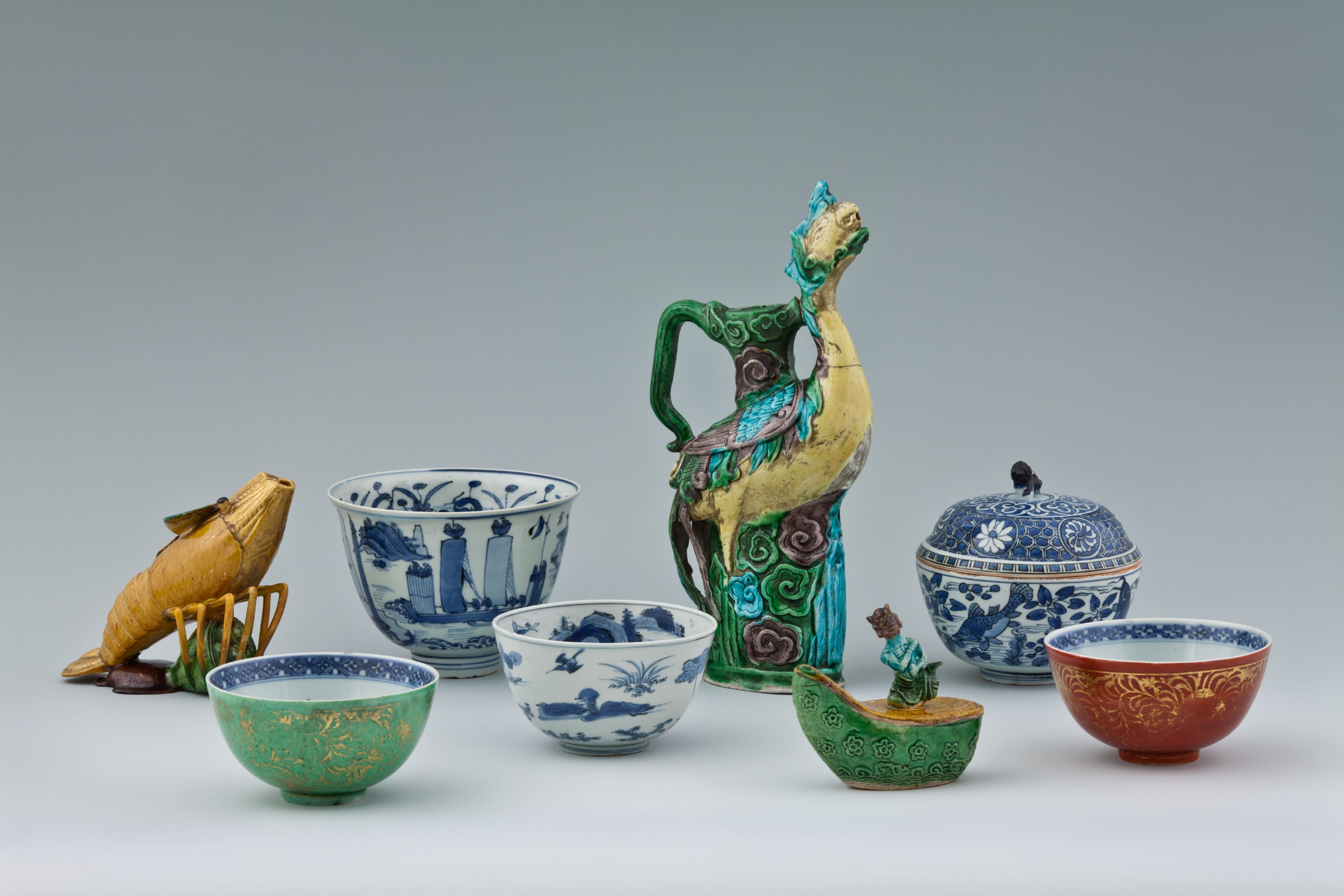
Fig. 3: Porcelain from the Medici gift 1590
China, Jingdezhen, Ming Dynasty (1368-1644), porcelain, underglaze cobalt blue, polychrome overglaze, gold, h. 6,3 – 28,5 cm, w. 9.9 – 14,7 cm; Dresden, Staatliche Kunstsammlungen Dresden, Porzellansammlung, PO 3226, PO 3227, PO 3228, PO 3229, PO 3478, PO 3479, PO 3791, PO3225
Porzellansammlung, Staatliche Kunstsammlungen Dresden,
photo: Jürgen Lösel.
Upon inventorisation, every porcelain piece received a mark that consisted of a number and a particular symbol, indicating in which chapter the piece was recorded. For example, the sixth chapter, which formed the largest section with a number of over 10,0005 pieces of blue-and-white porcelains, was assigned a zig-zag symbol (fig. 7). Together the number and symbol form what is referred to today as the Palace Number. It was either cut into the porcelain body or painted onto the glaze, and is a crucial piece of information that helps us today to determine the dating of the objects. Through a matching of the historic Palace Number and the Porzellansammlung’s current inventory number, about 90% of the 8,000 remaining East Asian porcelain objects from the former collection of Augustus the Strong could be matched with their historical inventory entry.6
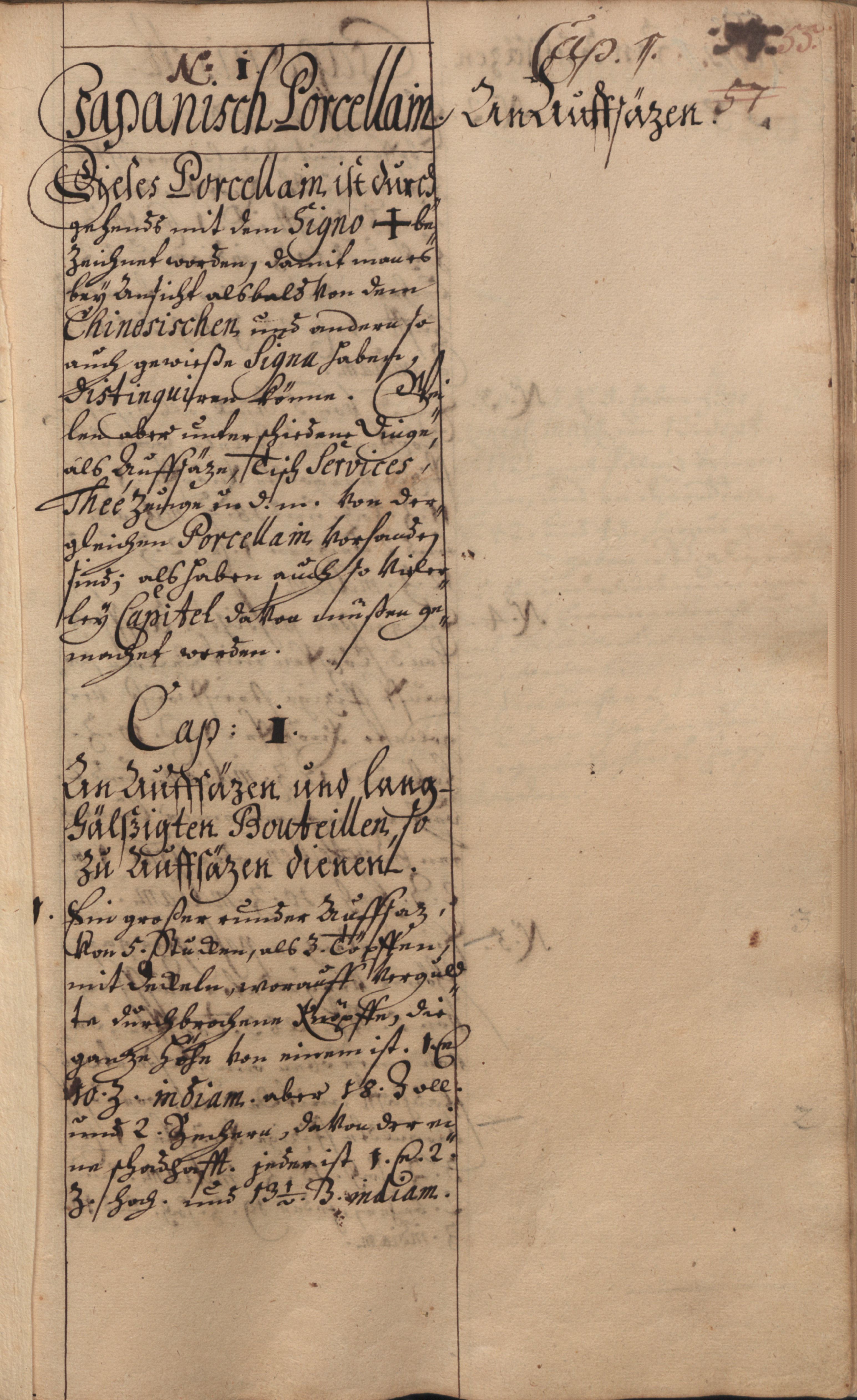
Fig. 4: Page from the royal inventories, chapter 1: Japanisch Porcellain, Dresden, 1721-1727;
Staatliche Kunstsammlungen Dresden,
Porzellansammlung.
The inventories not only give details on each object’s number, height, size and décor, but also provide important information about the dealers and suppliers of East Asian porcelain. The deliveries happened mostly in May, after the Leipzig Fair, which was held three times a year: at New Year’s, Jubilate Sunday (the third Sunday after Easter Sunday) and Michaelmas (29 September). However, porcelains also arrived at the Saxon court as diplomatic presents. The royal inventories also list deliveries from members of the Polish nobility, although these make up only a small fraction of the overall supply of East Asian wares. For example, two deliveries are recorded for April and May 1724, which came from Stanisław Chomętowski (1673-1728), Voivode of Masuria. With ninety-two objects, this part formed only a small percentage of the whole collection, and pales in comparison with the deliveries that came from Madame Anna Elisabeth de Bassetouche (died 1730).
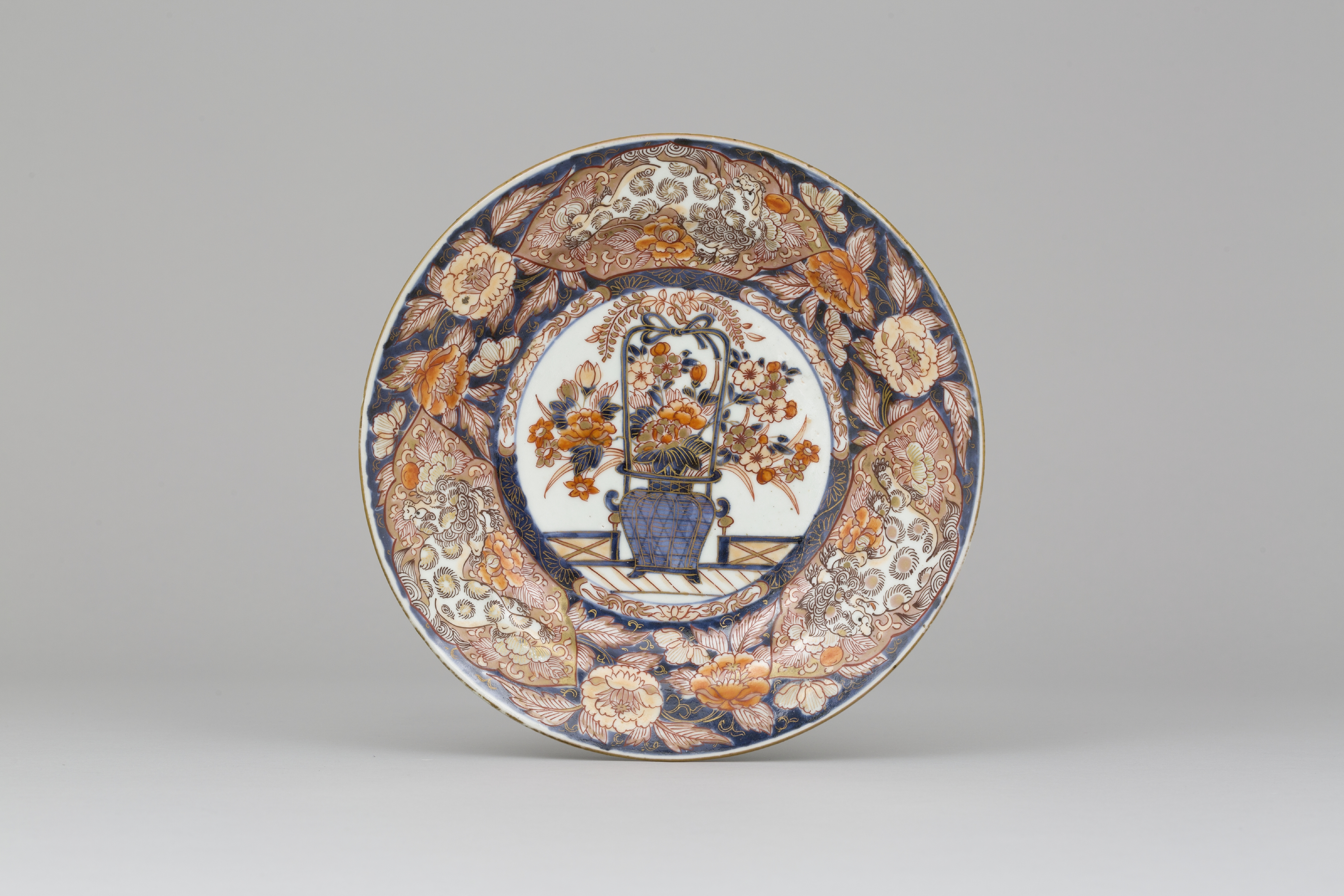
Fig. 5: Large Imari dish
Japan, Arita, 1700-1720, porcelain, underglaze cobalt blue, overglaze iron red, gold, 3,9 x 25,8 cm; Dresden, Staatliche Kunstsammlungen Dresden, Porzellansammlung, PO 2937;
Porzellansammlung, Staatliche Kunstsammlungen Dresden,
photo: Adrian Sauer.
Not much is known about Elisabeth de Bassetouche, but she is described in the inventories as “a Dutch woman”,7 indicating that she either originated from the Netherlands or probably from the German-Dutch border area. In a letter to the Saxon court from 1730 regarding the supply of Japanese porcelain dishes, Berlin (and not Dresden) is stated as her place of residence.8 Her maiden name was Van Wesel,9 and she was the wife of Charles Hurtelut, named “de Bassetouche”, a Huguenot language teacher living in Bremen around 1689.10 A marriage certificate from 4 April 1683, issued in the town of Kleve near the Dutch border, records the marriage of a woman named Anna Elisabeth van Wesel to a certain Carolus Desbasse.11 This couple is identical with the above-mentioned husband and wife who later made a name for themselves, given that the French surname experienced multiple way of writings. Charles de Bassetouche’s year of death is unknown, but in the documents surrounding the porcelain acquisitions from 1717 on, the title veuve – “widow” – is usually added to Elisabeth de Bassetouche’s name, implying her husband’s passing. A number of other traces indicate ties of the families Van Wesel/de Bassetouche to the area of today’s North-Rhine Westphalia, such as the Electress Sophia of Hannover (1630-1714) mentioning in a letter to Gottfried Wilhelm Leibniz (1646-1716) a “merchant named Bassetouche who was once a teacher of languages”12, or a court document stating a lawsuit of “Elisabeth de Bassetouche, née van Wesel” in regards to a mortgage on a property in the Lippe area in 1720.13 By the turn of the century, the family had established their lives in Berlin. As of 1699, Charles de Bassetouche worked in the position of Second Treasurer and court assistant in Berlin’s Huguenot quarter Dorotheenstadt, until he was appointed city councilman in 1705.14 This prestigious position indicates a certain amount of wealth, which goes in accordance with the court documents regarding Madame Bassetouche’s inheritance (over which her six children fought for about twelve years after her death). In these files, she is described as a woman who had “not only considerable amount of wealth, but also a house in Berlin (…) and a guesthouse in Ziesar15 alongside property (…).”16
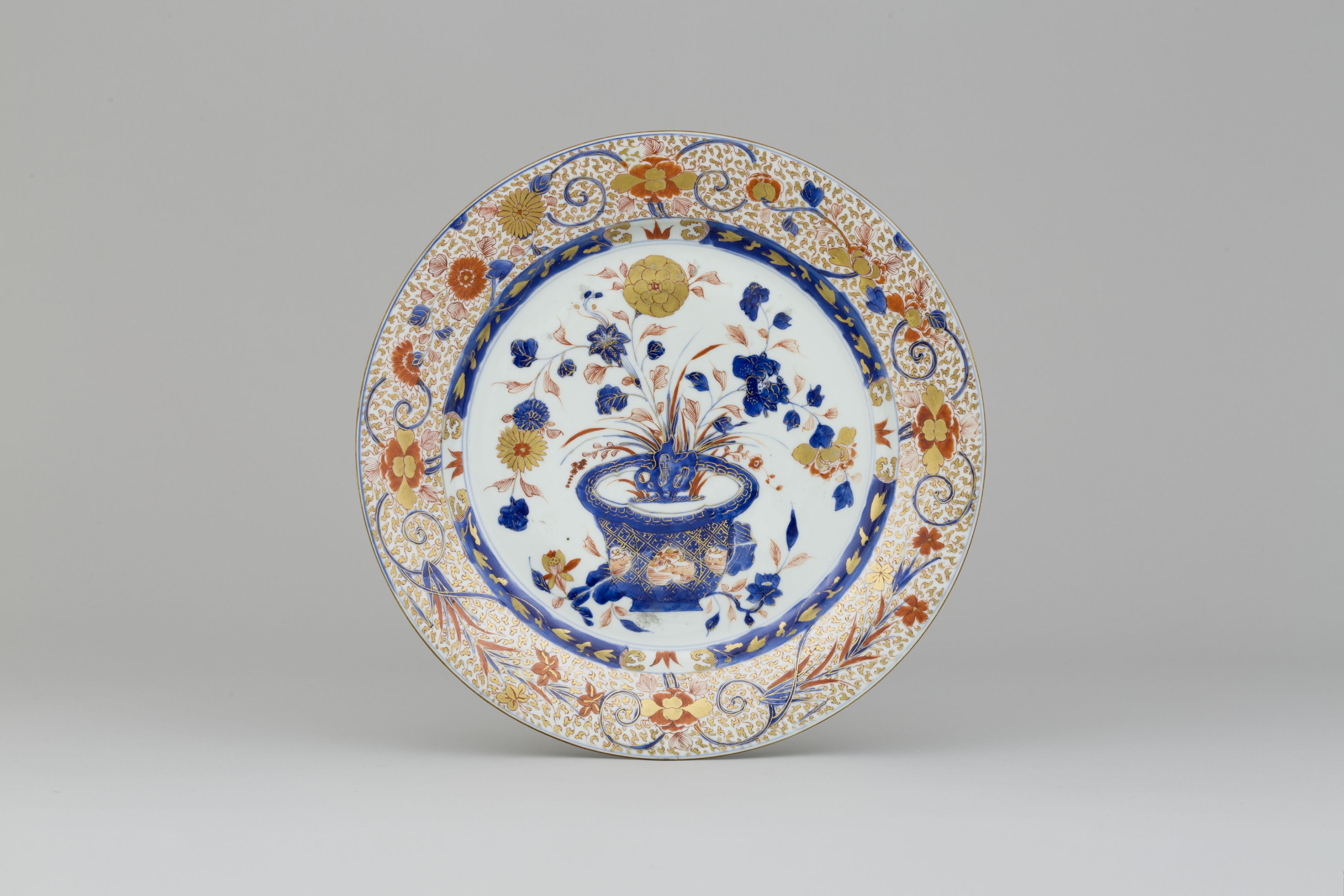
Fig. 6: Chinese Imari dish
China, Jingdezhen, Kangxi era (1662-1722), porcelain, underglaze cobalt blue, overglaze iron red, gold, 5,7 x 39,0 cm; Dresden, Staatliche Kunstsammlungen Dresden, Porzellansammlung, PO 5633;
Porzellansammlung, Staatliche Kunstsammlungen Dresden,
photo: Adrian Sauer.
Elisabeth de Bassetouche was the court’s number one supplier of East Asian porcelain, not only for the furnishing of the Japanese Palace, but also for festivities such as the Zeithain Encampment, a military parade held near the town of Meissen in 1730. As early as 1717, she had closed a contract with the Saxon court that covered the sale of a “great stock of porcelain and other Indian lacquered things, everything and all” that was stored in “five rooms of the (…) so-called Taschenberg”,17 a sum of 20,000 Reichstaler, to be paid in two installments of 10,000 Reichstaler each.18 Her name is mentioned forty-three times in the royal inventories, each time accompanied by a statement about the date and amount of deliveries. Further information on her activities have yet to be discovered, but it is possible that she acquired porcelain either directly in the Netherlands or at the Leipzig Fair. Other dealers in the inventories include the names of merchants from Dresden, including a Mr Konspruck, or the companies Landsberger & Comp and Valentin & Comp. The records of the Oberrechnungsdeputation, in which the King’s personal expenses were chronicled, confirm the inventory’s records, and offer information on the amount of money Augustus the Strong spent on his passion for porcelain.
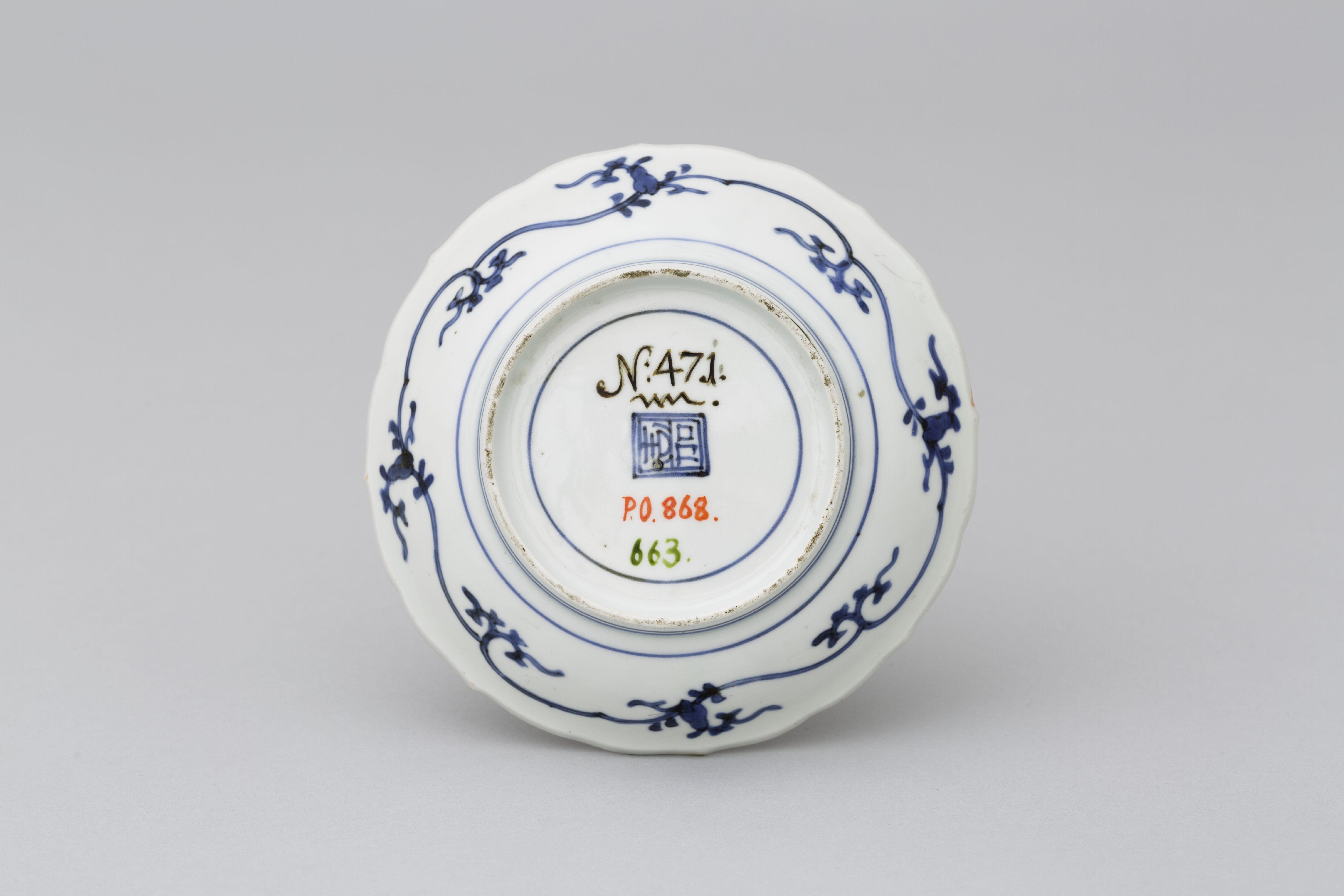
Fig. 7: Base of a blue and white dish with the Palace Number clearly visible; Japan, Arita, porcelain, underglaze cobalt blue, 3,4 x 14,4 cm
Dresden, Staatliche Kunstsammlungen Dresden, Porzellansammlung, PO 868;
Porzellansammlung, Staatliche Kunstsammlungen Dresden,
photo: Adrian Sauer.
Between 1716 and 1718, a great number of porcelain, luxurious fabrics, lacquerware and Asian artworks were bought in the Netherlands. The purchases were arranged by Peter Robert Taparelli, Count of Lagnasco (1659-1735), an Italian officer in the service of the Saxon court (fig. 8). He served in multiple diplomatic missions during the Great Northern War (1700-1721), which took him to the Netherlands, Italy, and Austria. Around July 1716, he travelled to Amsterdam and The Hague to take care of the inheritance of his late mother-in-law, the Countess de Noyelles (died 1716). At the same time, the King assigned him two tasks: investigating the opportunity to buy warships for the ongoing war, and scouting the art market of the Netherlands to buy porcelain and other luxuries for the furnishing of the Japanese Palace. A set of letters written in French between the King himself, Count Lagnasco, and two dealers in Amsterdam and The Hague, are kept today in the Dresden State Archives (loc. no. 380/03 and loc. no. 662/07) and date from the period between October 1716 and April 1718. The letters inform us that two larger purchases were made, both with the help of local individuals.
The first facilitator was Egidius van den Bempden (1667-1737), a Dutchman who belonged to one of the wealthy patrician families of Amsterdam (fig. 9). Until becoming one of the directors of the VOC in 1719 (the same year when he was elected mayor of Amsterdam), he was connected to the Sociëteit van Suriname (Society of Suriname), a company that was involved in the trade of sugar, coffee, cocoa and cotton from the Dutch colony.19 We do not know how exactly he became Lagnasco’s contact person, but his letters show that he was closely connected to several dealers from The Hague and Amsterdam. In addition to this, his ties to the VOC and his power to organize passports and have certain custom fees waived made him the ideal person to assist with acquisitions for his royal customer.
Van den Bempden was a very efficient intermediary, organizing the sourcing and acquisition of porcelain valued at a total of around 36,000 guilders. His duties included the communication and negotiation with other dealers, accepting their deliveries, paying them the correct sums of money, and handling the packing and shipping. In March 1717, a shipment of seventy crates left Amsterdam en route for Dresden, transported overland in accordance with the King’s wishes and not by ship via the Elbe river. A receipt signed by the coachmen Hans Echolt, Simon Haverman and Johann Komeiß confirms the arrival of the entire load in Dresden on 2 April 1717.20 The purchase had been finalized much earlier, as several invoices from 8 November 171621 reveal, but the climatic conditions during the winter made it necessary for the crates to be stored in Van den Bempden’s warehouse for three months, a service for which he charged “only 25 guilders.”22
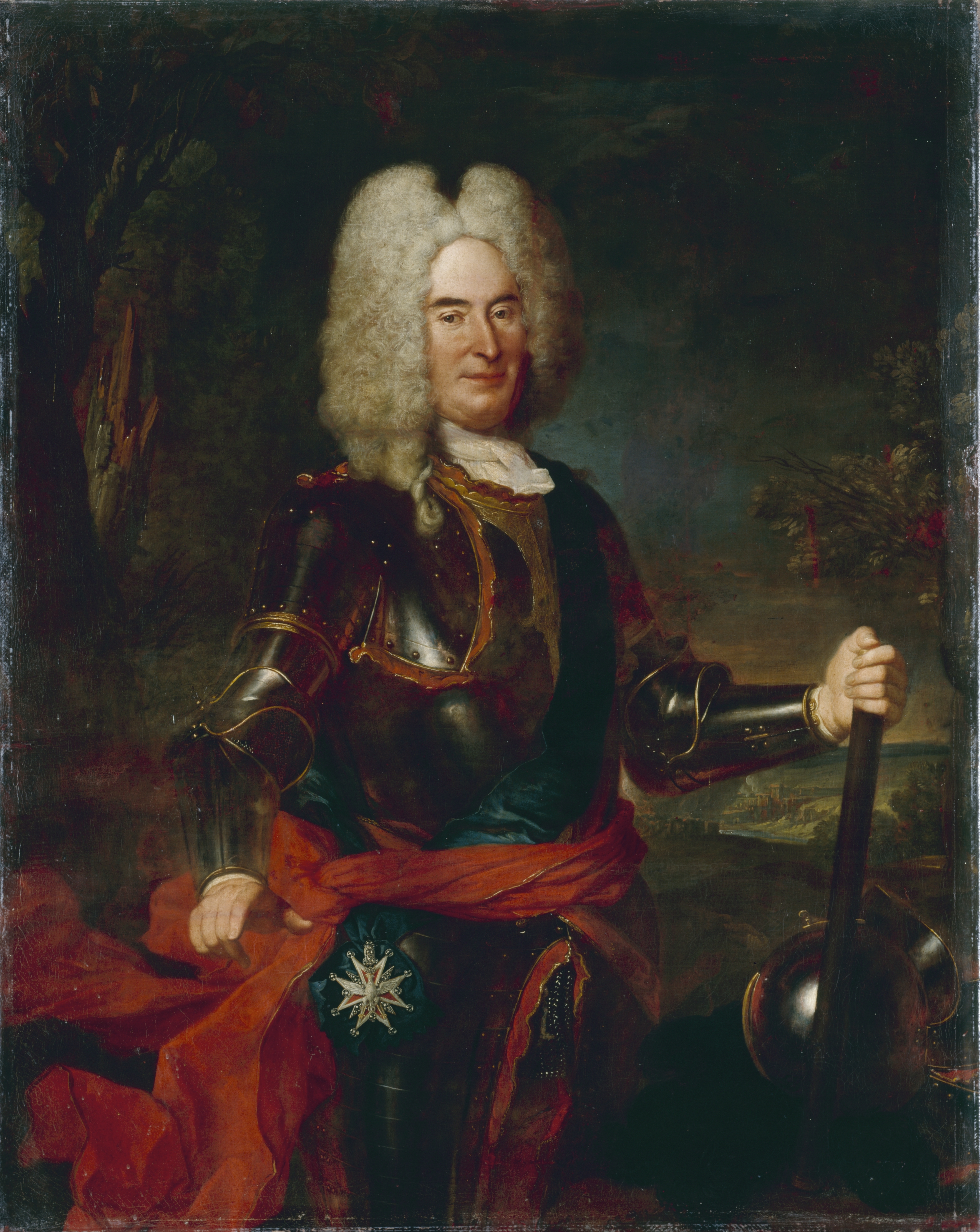
Fig. 8: Louis de Silvestre (1675-1760)
General Peter Robert Taparelli, Count of Lagnasco (1659-1735), 1724, oil on canvas, 141,7 x 112,8 cm ;
Dresden, Staatliche Kunstsammlungen Dresden, Gemäldegalerie Alte Meister, Gal. No. 3960;
Gemäldegalerie Alte Meister, Staatliche
Kunstsammlungen Dresden, photo: Hans-Peter Klut.
Porcelain acquisitions did not stop after these first successful deliveries from Holland, as we learn from another set of letters, dating from May 1717 to April 1718. The authors of these writings were the Martins, a husband and wife who were professional Asian art dealers in The Hague.23 The Martins are mentioned in Van den Bempden’s and Lagnasco’s letters several times, where they are listed as the suppliers of “5 Rouleaux à Cages à 300 F[lorins]”,24 five “beakers vases with cages” to be identified as “bird-cage vases” (fig. 10), Japanese beaker vases decorated with a lacquered wooden cage. It can be assumed that the task of acquiring porcelain for the King was passed on from Van den Bempden to the Martins after the former concluded his business successfully in March 1717.
The Martins’ letters are more personal than those of Van den Bempden, mentioning private details such as stays in Aix-la-Chapelle (then as now a popular spa resort), information on their general wellbeing, or passing on greetings from other acquaintances. From this less formal tone of the writings, it can be assumed that the purchases made via this couple were probably not only intended for Augustus the Strong, but also included private acquisitions for Lagnasco himself, mostly including tea, chocolate, books and smaller fashion accessories such as fans for the Countess. The porcelain, however, was meant for the King, and Madame Martin was eager to please her royal customer with her discoveries. She repeatedly travelled to Amsterdam, especially when “the ships arrived from India”, to “see if there are any interesting things to discover.”25 By 1717, word of Augustus the Strong’s plans for the Japanese Palace had clearly reached Holland, which becomes apparent from a note from Monsieur Martin, who confides in Lagnasco that his “wife wishes to have wings, so that she could see His Majesty’s wonderful palace.”26
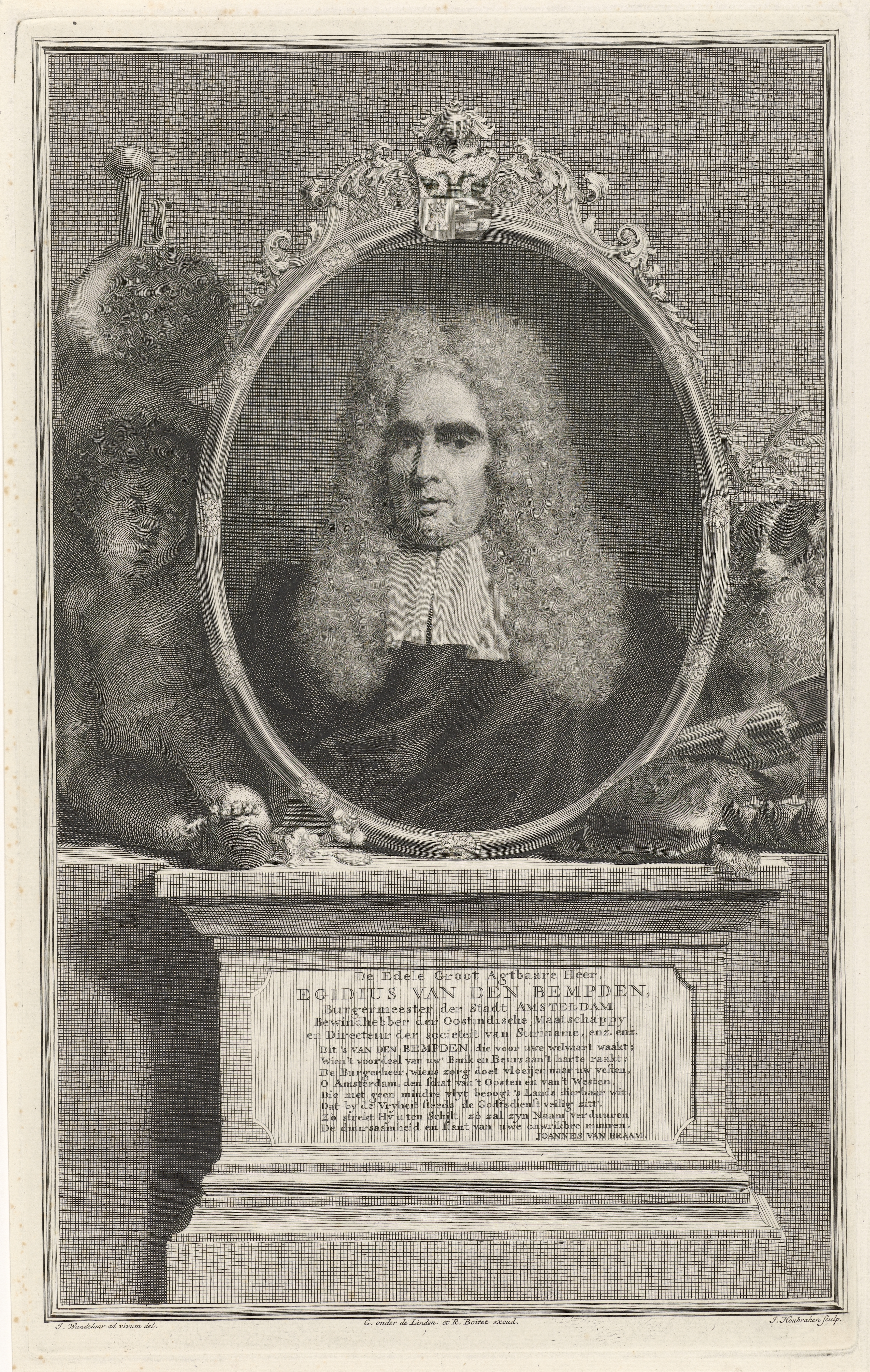
Fig. 9: Jacob Houbraken (1708-1780)
Portrait of Aegidius van den Bempden (1667-1737) after Jan Wandelaar (active 1711-1758), 1719-1737, engraving on paper, 37,0 x 23,0 cm;
Amsterdam, Rijksmuseum Amsterdam, RP-P-OB-48.824;
Rijksmuseum, Amsterdam.
The Martins had similar duties to Van den Bempden, and although no report on a commission exist, invoices and payment (or the lack thereof) make up a significant amount of the overall communication. Dealing with the Martins apparently went less smoothly than with Van den Bempden. More than once, Madame Martin apologizes for letters not arriving at their destination, or for incomplete deliveries such as one containing pieces of a “Japanese blue service (…), four candleholders and eight bowls with lids”.27 However, we understand that the Martins had a considerable network of both collectors and merchants to rely on, and access to members of a higher social class. This is evident in repeated reports from Madame Martin about her attempts to persuade the Earl of Albemarle28 to sell some of his porcelain to the King: “Mylord [Albemarle] is in Voorst,29 but as soon as he is back in The Hague, I will not fail to see him on the pretext of another cause and then ask him if he does think of selling any of his porcelain. If so, I will do my best to get the best price for you.”30 Two weeks later, Madame Martin writes that “(…) Mylord made me understand that he does not wish to part with his porcelain, and I did not dare to make him any offer. I am convinced that I will have better luck with Mylady [Albemarle], with whom I can speak more openly, what I will do once she has returned from Voorst.”31 There is no reference to a successful purchase in the remaining letters, although Monsieur Martin mentions that Lord Albemarle suggested a deal – porcelain in exchange for Tokaji wine – which was apparently rejected by Madame Martin.32
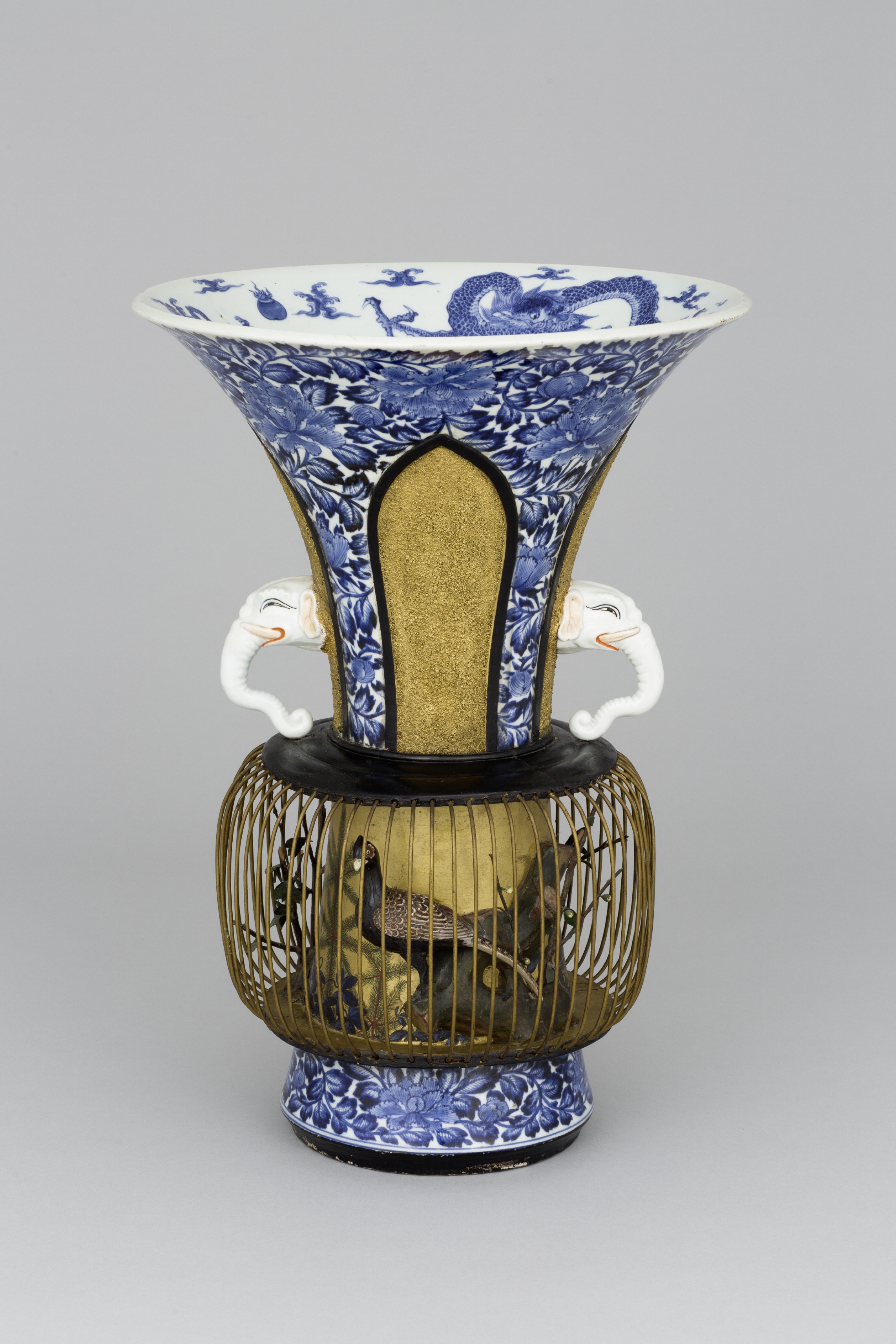
Fig. 10: Bird cage vase;
Japan, Arita, 1690-1720, Porcelain, metal, wood, paper, lacquer, gold, 51,5 x 37,0 cm
Dresden, Staatliche Kunstsammlungen Dresden, Porzellansammlung, PO 3801;
Staatliche Kunstsammlungen Dresden, Porzellansammlung, photo: Adrian Sauer.
Other than with the purchases made by Egidius van den Bempden, no invoices or larger receipts have survived, which could give us an idea about the overall numbers or value of purchases. However, a Spezifikation (listing) produced by Saxon court officials (fig. 11), kept today in the archives of the Porzellansammlung, records “those lacquered objects and porcelains (…) which come from Holland and which (…) were brought to the Royal Palace in Alt-Dresden on 20 June 1718.”33 The specific reference of Holland as the origin and the close dating of both the Martin’s last letter (8 April 1718) and the Spezifikation suggest that the objects described in the file are porcelain pieces acquired with the help of the Martins, having arrived in Dresden shortly thereafter. The list mentions 1,231 objects, divided in lacquerworks, Weiß Porcelain (white porcelain), alt blau Porcelain (old blue porcelain), Goboisch Porcelain and Japanisch Porcelain (Japanese porcelain). As these porcelain pieces were taken to the Japanese Palace, they must have been included in the historic royal inventory discussed above, most likely in chapter one, three and six. Due to the overly general description of the objects in the Spezifikation, it is unfortunately not possible to precisely identify all their matching entries in the royal inventories, although a concordance may be established for those entries in the inventory which are recorded without any information on a supplier. The inventories provide the names of dealers and delivery dates no earlier than from 1721. Thus, any objects without information on their provenance must have entered the Royal Collection before this date. Following this system, one can match an entry in the Spezifikation describing “2. hexagonal coffee pots with white figures, lids, grips and a spout, from one a piece is broken off” with two inventory records, each describing a “hexagonal teapot having cartouches sprigged with moulded figures, a grip, a spout and a flat hexagonal cover.” Both items are listed in the royal inventories without acquisition information in the third chapter under Palace Number N. 1 ∆ and N. 3 ∆, of which only the former is still extant (PO 8233, fig. 12).34 Likewise, the Spezifikation’s listing of “2. butter boxes, each one with 3 blue feet and small figures on the lid”35 can be identified as two Imari boxes (PO 4872 and PO 4873), described in the royal inventories as “2 butter boxes, each with 3 small blue feet and a bowl-shaped cover upon which 3 small pagods sit”, listed under Palace Number N 28 + (fig.s 13, 14). 36
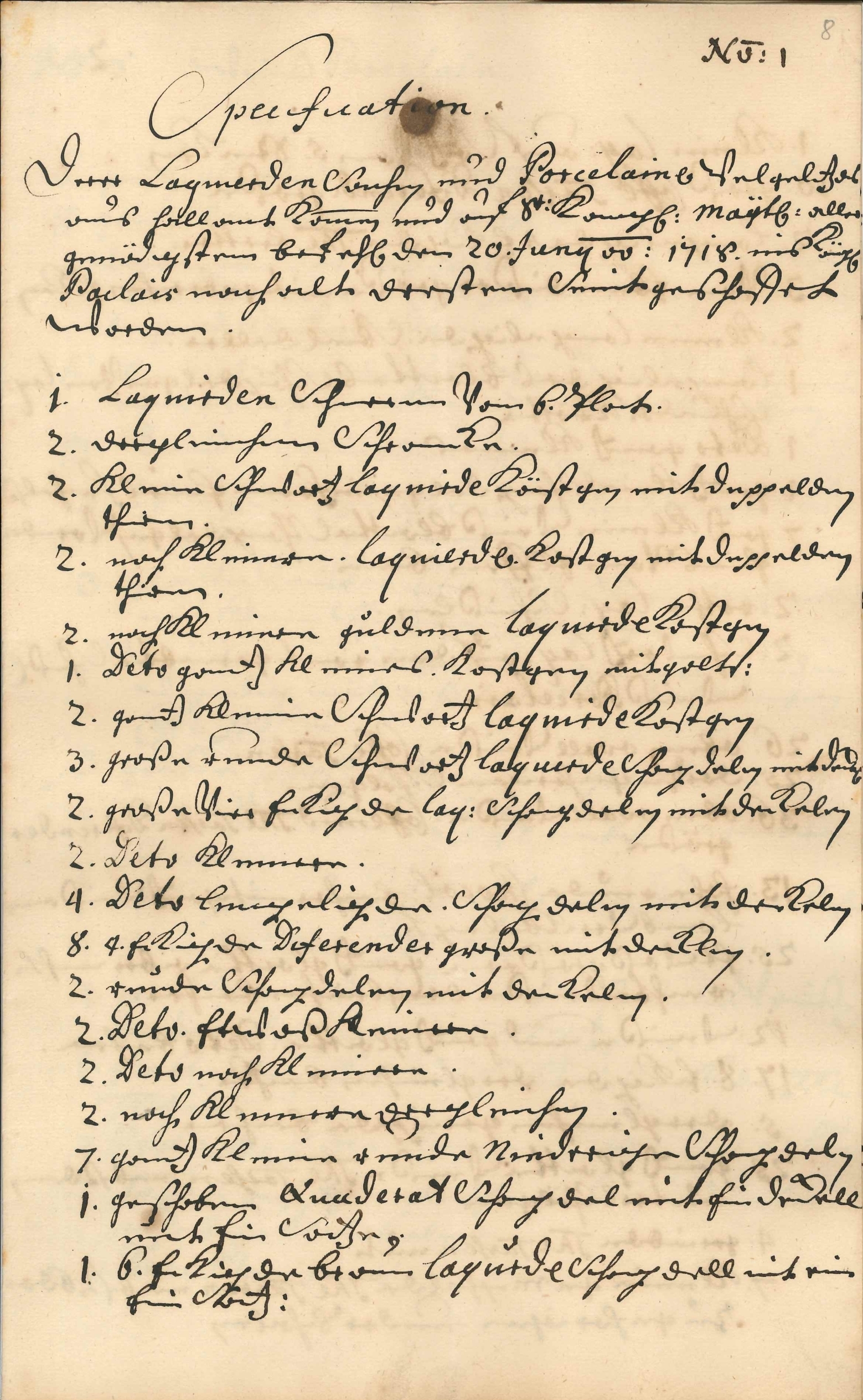
Fig. 11: Front page of the Spezifikation of lacquer and porcelain acquisitions, Dresden, 1718;
Staatliche Kunstsammlungen Dresden, Archiv Porzellansammlung, II. K.1.1.
From the letters exchanged between Augustus the Strong, Count Lagnasco and the Dutch dealers, we understand that the acquisition of porcelain was not only a costly and time-consuming undertaking, but also that competition among the buyers was fierce, and that Lagnasco sometimes had to pass on some buying opportunities due to the lack of funds. Although there was an ample supply of luxury objects in the Netherlands, those were often enough sold to other buyers before money from Saxony arrived in the Netherlands. Shortly before the eventual dispatch of the purchases made under his supervision, Van den Bempden reports that he even had to decline a request from Czar Peter the Great (1672-1725) to see the porcelains stored in his warehouse, telling him that “they have been shipped already, and that they are in His Majesty’s possession anyway.”37 On the other hand, the rich supply of luxury goods made it possible for the dealers to be selective in their choices, and to negotiate prices in order to get the best deal for their clients. Likewise, we understand that despite the apparently random choices during the acquisition of porcelains, the objects that were bought for Augustus the Strong were carefully chosen and systematically purchased. This becomes particularly clear with the description of the acquisition process of various table services, which had to be bought from numerous sources in order to assure a homogeneous appearance of the overall set.
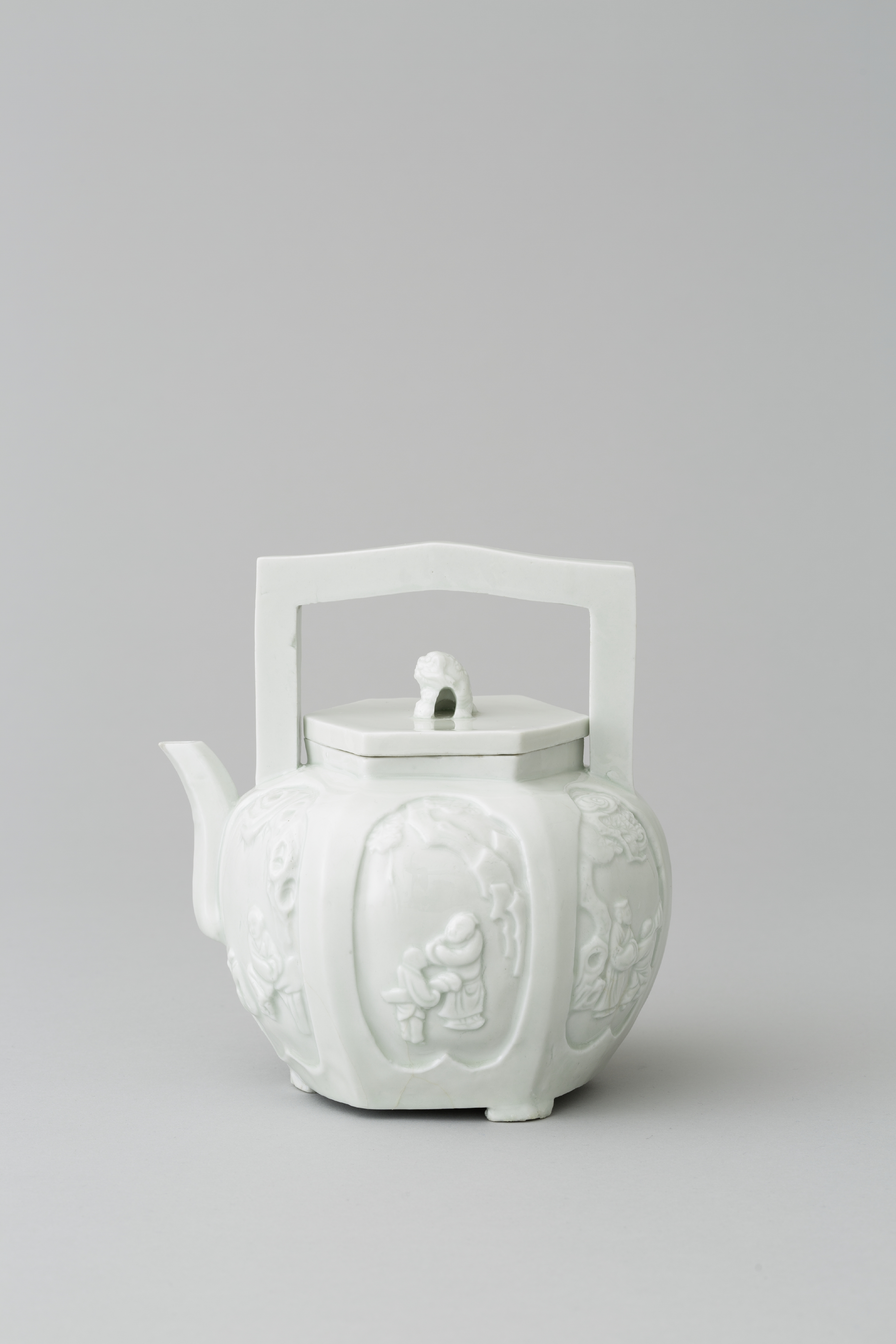
Fig. 12: Blanc de Chine pot;
China, Dehua, 1690-1720, porcelain, 19,9 x 18,7 x 15,9 cm;
Dresden, Staatliche Kunstsammlungen Dresden, Porzellansammlung, PO 8233;
Staatliche Kunstsammlungen Dresden, Porzellansammlung, photo: Adrian Sauer.
This article aims to underline the importance of porcelain dealers working outside the major trading companies for the assembly of Augustus the Strong’s East Asian porcelain collection. Having a local person acting as a middleman was essential to the buyer, as the correspondents not only had the networks to know where the best bargains could be found, but also possessed a knowledge of the market and the values of porcelain to know what prices were appropriate. As we see from the example of Egidius van den Bempden, his influential position was useful even after the completion of the porcelain purchases, as it was in his power to have custom fees waived and bureaucratic processes (such as the issuing of a passport) expedited.
Only part of the letters between Augustus the Strong and his porcelain suppliers could be described in this article, and while we gain an essential understanding of the Dutch porcelain market in the early eighteenth century, there is still a lot of information left to be discovered. Regarding the Dutch acquisitions by Lagnasco, we do not know exactly how the contact to Van den Bempden was established, or why the Martins replaced him as correspondents in May 1717. Likewise, it is not clear whether the objects intended for Augustus the Strong were solely new arrivals that came directly from Asia via the VOC, or if a part of them were also “second-hand wares” acquired from private collections, although the exchange between Madame Martin and Lord Albemarle certainly suggests that this was the case. This article, however, aimed to shed light on the importance of private dealers working outside the main trading companies for the emergence of the porcelain collection of Augustus the Strong. Further research on this topic is currently conducted in the research project “Microstructures of Global Trade. The East Asian Porcelain in the Collection of August the Strong in the Context of the Inventories from the 18th Century”, sponsored by the Deutsche Forschungsgemeinschaft, as well as the “Dresden Porcelain Project”, an international effort initiated by the Porzellansammlung to catalogue the complete extant collection of East Asian porcelain originally in Augustus the Strong’s collection.
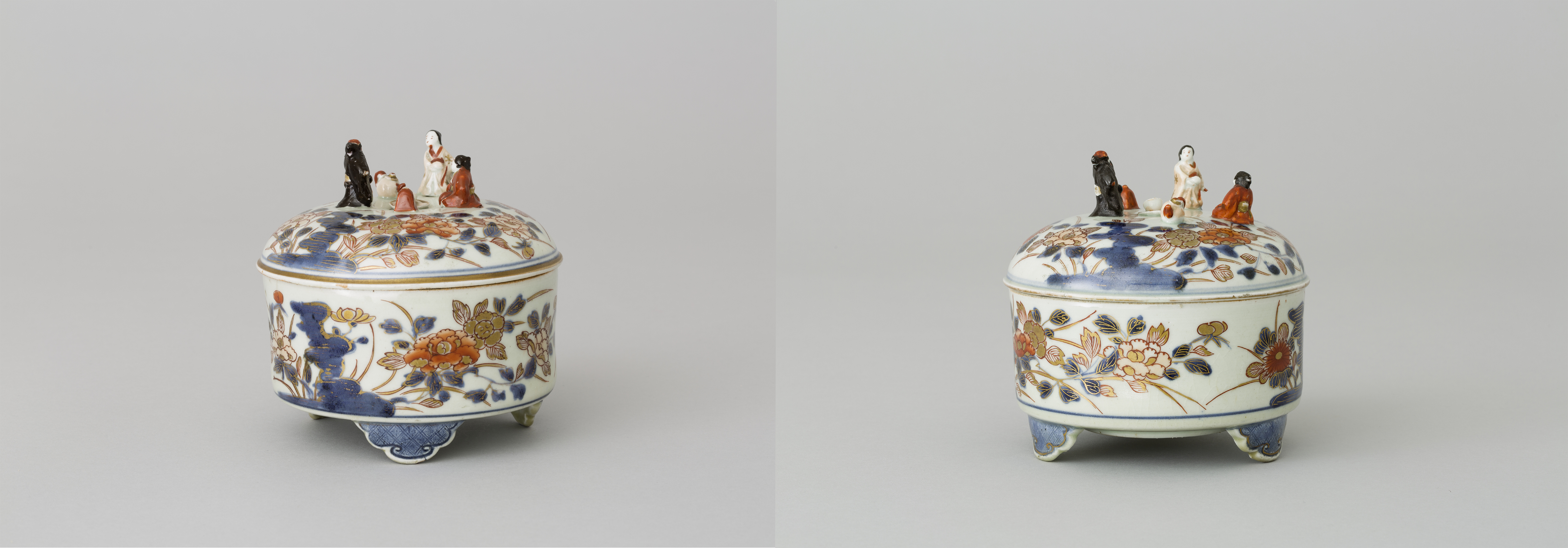
Fig.s 13, 14: Imari box with lid; Japan, Arita, 1700-1720, porcelain, underglaze cobalt blue, overglaze iron red, black, gold 13,7 x 13,5 cm Dresden, Staatliche Kunstsammlungen Dresden, Porzellansammlung, PO 4872 (left), PO 4873 (right);
Staatliche Kunstsammlungen Dresden, Porzellansammlung, photo: Adrian Sauer.
Ruth Sonja Simonis is a researcher at the porcelain collection (Porzellansammlung) at the Staatliche Kunstsammlungen Dresden.
1 Number derived from an overall count of all East Asian ceramics recorded in the 1721-1727 inventories, conducted by the Porzellansammlung in 2014/2015.
2 Of the 25,000 objects, around 8,000 are still extant today and kept in the Porzellansammlung.
3 References to later additions in the inventories indicate that roughly 100 pages of the inventory were lost. Today, the record comprises 884 pages.
4 The usage of „Krack“ is deceptive, as the term “Kraak” today describes Chinese and Japanese blue-and-white wares that were produced solely for export and the first porcelain to arrive in Europe on Portuguese ships (carracks) in the sixteenth century. In the 1721 inventories, the porcelain subsumed under this denominator are assorted objects that apparently did not fit into any particular category. Some of these would today be classified as Japanese Kakiemon porcelain, which is characterized by delicate decoration in polychrome overglaze.
5 It can be assumed that the overall number of objects was even higher, due to the missing 100 pages from the original inventory.
6 The remaining 10% could not be matched due to missing or incomplete Palace Numbers. However, it can still be assumed that they used to be part of the former royal collection due to similarities to identified objects in décor, colour palette, or quality of the porcelain.
7 SKD inventories, Nr. 324, INVENTARIUM über das Palais zu Alt Dresden. Anno 1721, pag. 764.
8 HStA Dresden, Oberhofmarschallamt, Akte G, Nr. 30a, Kampement bei Radewitz [Zeithainer Lager], 1730, fol. 207. See Maureen Cassidy-Geiger, Innovations and the Ceremonial Table in Saxony, 1719 – 1747, in Peter-Michael Hahn, Ulrich Schütte, eds., Zeichen und Raum. Ausstattung und Zeremoniell in den deutschen Schlössern der frühen Neuzeit. Rudolstädter Forschungen zur Residenzkultur, vol. 3 (Berlin and Munich: Deutscher Kunstverlag, 2006), 135-65.
9 Elisabeth de Bassetouche‘s maiden name is stated in court documents regarding her testament. See HStA Dresden, 10035 Geheimes Konsilium, Loc. 05603/01, Anna Elisabeth de Bassetouches Verlassenschaftssache, 1742-1744. It is also written as De Wesel or Wentwessel. Wilhelm Beuleke, Bremisches Jahrbuch, herausgegeben von der Historischen Gesellschaft, vol. 39 (Bremen: Arthur Geist Verlag, 1939, No. 75), 32.
10 Beuleke, Bremisches Jahrbuch, 32.
11 Carolus Desbasse and Elisabeth Anna Van Wesel, 04 Apr 1683; citing Evangelisch, Cleve, Rheinland, Prussia; https://www.familysearch.org/ark:/61903/1:1:JH3H-QY5 (accessed 12 March 2018)
12 Letter from June 23, 1700, published in Wenchao Li, ed., Gottfried Wilhelm Leibnitz. Kurfürstin Sophie von Hannover. Briefwechsel (Göttingen: Wallstein Verlag, 2017), 313.
13 Stefi Jersch-Wenzel, Reinhard Rürup, eds., Quellen zur Geschichte der Juden in den Archiven der neuen Bundesländer (München: K.G. Saur, 2001), 84.
14 Erika Schachinger, Die Dorotheenstadt 1673-1708: eine Berliner Vorstadt. Veröffentlichungen aus den Archiven Preussischer Kulturbesitz (Köln: Böhlau, 2001), 25-30.
15 Ziesar is located in today’s Brandenburg, about 100 kilometers south-west of Berlin.
16 “Es hat die allhier verstorbene Porcellain-Händlerin Anna Elisabeth des Bassetouches, nicht nur allhier ein ziemliches Vermögen, sondern auch in Berlin ein Haus nebst anderen Erbschafts-Effecten, ingleichen in Ziesar einen Gasthoff samt zugehörigen Felde hinterlaßen (...).” HStA Dresden, Loc. 13957/01, Die hinterlassenen Kinder und Erben von Anna Elisabeth verwitwet gewesene Bassetouche, namentlich die Brüder Wilhelm Ludwig, Gerhard und Christian Vincentius Bassetouche, zugleich Johann Christoph Hornemann als Erben seiner verstorbenen Ehefrau, Catharina Elisabeth, ehemals Erbin und Witwe von Jacob Bassetouche, sowie die mitklagende Maria Elisabeth Morath, geborene Bassetouche, gegen den zum Kreditwesen von Sophie Charlotte ehemals Eger, nun verehelichte Franckenstein, verordneten curatorem litis et bonorum, Gottlob Heinrich Vogler, gegen den mitbeklagten Carl Christian Eger, königlich-polnischen und kurfürstlich-sächsischen Kammerkommissar, sowie die mitbeklagte Anna Sibylle Meinhardt, wegen Erbschaftsdifferenzen, 1739-1742, fol. 9.
17 The Taschenberg was a palace built right next to the Royal Castle between 1705-1708 for Augustus the Strong’s mistress Anna Constanze von Hoym (1680-1765).
18 HStA Dresden, 13472 Schatullenkasse, Schatullenrechnungen Friedrich August I., Kurfürst von Sachsen und Königs von Polen, Königl. Rechnung, no. 35, fol. 139r.
19 Johan Engelbert Elias, De vroedschap van Amsterdam, 1578–1795, met een inleidend woord van den archivaris der stad Amsterdam Mr. W.R. Veder, (Haarlem: Loosjes, 1903), 664.
20 HStA Dresden, 13472 Schatullenkasse, Schatullenrechnungen, no. 35, fol. 58r.
21 HStA Dresden Loc. 380/03, Papiers, concernant les emplettes des porcelaines en Hollande, minutes des rapports au Roi du Comte de Lagnasce lorsqu’il fut en Hollande pour ses propres affaires, ou sont joints(?) les ordres de Sa Majesté les emplettes de vases de Delft Porcelaines, toiles, pintes et vaisseaux armes en guerre pour le service du Roi avec les minutes des lettres écrites à diverses personnes par le dit Comte Lagnasce, invoice from 8 November 1716, fol. 156v.
22 HStA Dresden, 13472 Schatullenkasse, Schatullenrechnungen, no. 35, fol. 52-53.
23 In the letters and invoices, the Martin’s name is constantly written as “St. Martin”, which was probably the couple’s dit name. While we know the husband’s first name – Jean -, his wife remains anonymous, as she signed her letters only with her last name.
24 HStA Dresden, Loc. 662/07, Lettres du Comte de Lagnasc, invoice from 27 February 1717, fol. 75r.
25 HStA Dresden, Loc. 380/03, Papiers, letter from 31 July 1717, fol. 287v.
26 HStA Dresden, Loc. 380/3, Papiers, letter from 21 August 1717, fol. 291v.
27 HStA Dresden, Loc. 380/3, Papiers, letter from 29 May 1717, fol. 282r.
28 Arnold Joost van Keppel, 1st Earl of Albemarle, 1670-1718.
29 The Huis de Voorst, Lord Albemarle’s pleasure palace, about ten kilometers from Apeldoorn.
30 HStA Dresden, Loc. 380/3, Papiers, letter from August 24, 1717, fol. 293r. The Earl of Albemarle, a favourite of Queen Mary II. of England (1662-1694), inherited most of the Queen’s porcelain after her death. This royal provenance might have appealed to both the Martins and Augustus the Strong. See John Ayers, Chinese and Japanese Works of Art in the Collection of Her Majesty the Queen, 3 vols., vol. 1 (London: Royal Collection Trust, 2016), 108.
31 HStA Dresden, Loc. 380/3, Papiers, letter from 7 September 1717, fol. 294r.
32 HStA Dresden, Loc. 380/3, Papiers, letter from 29 January 1718, fol. 344v.
33 Staatliche Kunstsammlungen Dresden, Archiv Porzellansammlung, II K. 1.1, Holländisches Ballais Sachen betr. 1717, 1718, Spezifikation Lackwaren und Porzellan 1718, fol. 8r.
34 “N. 1. One hexagonal teapot having cartouches sprigged with moulded figures, a grip, a spout and a flat hexagonal cover surmounted by a tiny recumbent lion and hand-grip instead of a knop, 8½ in. high and 7 in. in diam.” SKD Inventare, Nr. 324, INVENTARIUM über das Palais zu Alt Dresden. Anno 1721., pag. 243. The inventory entry for N. 3 ∆ specifies that the teapot is “somewhat damaged”, making it possible to be the second teapot that is mentioned in the Spezifikation.
35 SKD, Archiv PS, II K 1.1, Holländisches Ballais Sachen betr. 1717, 1718, Spezifikation Lackwaren und Porzellan 1718, fol. 11v.
36 “N. 28. 2 butter boxes, each with 3 small blue feet and a bowl-shaped cover upon which 3 small pagods sit. Each is 6 in. high inclusive of cover and pagods and 5½ in. in diam.” SKD inventories, no. 324, INVENTARIUM über das Palais zu Alt Dresden. Anno 1721, pag. 78.
37 HStA Dresden, Loc 380/03, Papiers, letter from February 5, 1717, fol. 232r.